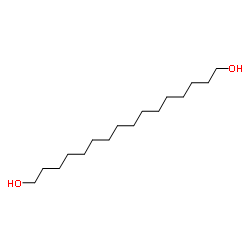1,2-十六烷二醇

1,2-十六烷二醇结构式

|
常用名 | 1,2-十六烷二醇 | 英文名 | 1,16-HEXADECANEDIOL |
|---|---|---|---|---|
| CAS号 | 6920-24-7 | 分子量 | 258.45 | |
| 密度 | 0.9±0.1 g/cm3 | 沸点 | 361.9±0.0 °C at 760 mmHg | |
| 分子式 | C16H34O2 | 熔点 | 68-72ºC(lit.) | |
| MSDS | 中文版 美版 | 闪点 | 164.9±13.6 °C |
|
Au-Edged CuZnSe2 Heterostructured Nanosheets with Enhanced Electrochemical Performance.
Small 11 , 3583-90, (2015) Two-dimensional (2D) nanomaterials and heterostructured nanocrystals (NCs) are two hot topics in current nanoresearch. However, reports on heterostructured NCs with 2D features are still rare. In this work, we demonstrate a one-pot colloidal chemistry route f... |
|
|
Synthesis of magnetic cobalt ferrite nanoparticles with controlled morphology, monodispersity and composition: the influence of solvent, surfactant, reductant and synthetic conditions.
Nanoscale 7 , 19596-610, (2015) In our present work, magnetic cobalt ferrite (CoFe2O4) nanoparticles have been successfully synthesised by thermal decomposition of Fe(III) and Co(II) acetylacetonate compounds in organic solvents in the presence of oleic acid (OA)/ oleylamine (OLA) as surfac... |
|
|
Magnetic nanoclusters engineered by polymer-controlled self-assembly for the accurate diagnosis of atherosclerotic plaques via magnetic resonance imaging.
Macromol. Biosci. 14(7) , 943-52, (2014) Oleyl dextran-coated magnetic nanoclusters (ODMCs) are fabricated for the accurate detection of macrophage-rich atherosclerotic plaques using magnetic resonance (MR) imaging. Dextran is introduced to the cluster surface of magnetic nanocrystals (MNCs) through... |
|
|
Developing functionalized Fe3O4-Au nanoparticles: a physico-chemical insight.
Phys. Chem. Chem. Phys. 17(8) , 6087-97, (2015) Nanotechnology for biomedicine has recently attracted increasing interest from the scientific community. In particular, among the different nanodevices suitable for this application, multifunctionalizable hybrid nanoparticles are one of the most investigated ... |
|
|
Synergistic geometric and electronic effects for electrochemical reduction of carbon dioxide using gold-copper bimetallic nanoparticles.
Nat. Commun. 5 , 4948, (2014) Highly efficient and selective electrochemical reduction of carbon dioxide represents one of the biggest scientific challenges in artificial photosynthesis, where carbon dioxide and water are converted into chemical fuels from solar energy. However, our funda... |
|
|
Exposure to Iron Oxide Nanoparticles Coated with Phospholipid-Based Polymeric Micelles Induces Biochemical and Histopathological Pulmonary Changes in Mice.
Int. J. Mol. Sci. 16 , 29417-35, (2015) The biochemical and histopathological changes induced by the exposure to iron oxide nanoparticles coated with phospholipid-based polymeric micelles (IONPs-PM) in CD-1 mice lungs were analyzed. After 2, 3, 7 and 14 days following the intravenous injection of I... |
|
|
Synthesis and properties of Au-Fe3O4 heterostructured nanoparticles.
J. Colloid. Interface Sci. 374(1) , 96-101, (2012) Au-Fe(3)O(4) composite nanoparticles have received much research interest due to their promising biomedical applications. In this work, Au-Fe(3)O(4) composites with well-defined dimer-like nanostructure were synthesized via thermal decomposition route. The su... |
|
|
Faceting of nanocrystals during chemical transformation: from solid silver spheres to hollow gold octahedra.
J. Am. Chem. Soc. 128 , 12671, (2006) We demonstrate that performing a replacement reaction on single crystalline Ag nanospheres of approximately 10 nm in diameter in an organic solvent produces hollow Au nanocrystals with an octahedral shape. Different from those Au shells made by starting with ... |
|
|
Monodisperse FePt nanoparticles and ferromagnetic FePt nanocrystal superlattices
Science 287(5460) , 1989-92, (2000) Synthesis of monodisperse iron-platinum (FePt) nanoparticles by reduction of platinum acetylacetonate and decomposition of iron pentacarbonyl in the presence of oleic acid and oleyl amine stabilizers is reported. The FePt particle composition is readily contr... |
|
|
Controlled colloidal synthesis of iron pyrite FeS2 nanorods and quasi-cubic nanocrystal agglomerates.
Nanoscale 6(2) , 1029-37, (2014) Earth-abundant and nontoxic pyrite iron disulfide (FeS2) is very promising for photovoltaic applications but the phase purity and the morphology of iron pyrite nanocrystals (NCs) have a significant impact on the solar cell performance. In this work, we system... |